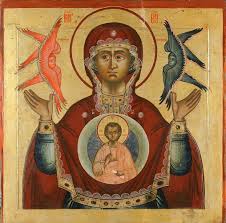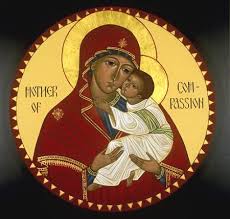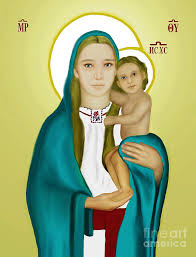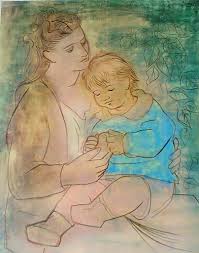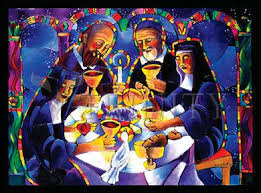
and the communion of saints
-
The friends of God and Jesus Christ constitute the communion of saints. Among them are Miryam and Joseph, Peter and Paul, Augustine, Francis, etc., and many recent saints, and also deceased family members and friends. Our Christian consciousness is only as vast as our memories, that is, our memories of all the friends of God.
-
Mary has often been made a goddess or superstar in popular devotions. She is also called the theotokos, the Christ-bearer. Filled with the Spirit, Miryam was the first first-born in the Spirit; she is the new Eve or mother of all those reborn. As a friend of God, she is a friend of all friends of God, a friend of all Christians. One cannot be a friend of the friends of God when Miryam is excluded. She is not a superstar but a model as first-born. She was also part of the apostolic college in the days before Pentecost.
Discussion:
1. The communion of saints and the theology of death
In 1945 four men were murdered by the National Socialists (NAZI) in the German town of Lubeck. Three were Catholic priests (Johannes Prassek, Hermann Lange und Eduard Müller), the fourth was a Lutheran pastor (Karl Friedrich Stellbrink). Three years ago the Catholic priests were declared 'blessed' by the Church, but not the Lutheran pastor. This was not an affront. As the Protestant Bishop explained, God had already declared all four as blessed at the moment of their death. But it raises a question for all Christians about the notion of 'sainthood' and therefore, of the communion of saints.
The communion of saints is not so much an exclusive club, as a reality of union with and communion in Christ, in whom God is reconciling all of creation to God's self. Union with God and communion with others is not restricted to those who are dead. Like the basileia tou theou, it is already and yet to be.
What I find critical in any discussion of the communion of saints is the challenge that is presented to the very notion of communion by the excessive emphasis on autonomy in Western culture. The connection between and among human beings is more and more tenuous in law and in cultural practice. We live in a loosely coupled human milieu. This understanding of autonomy makes death either a personal option (as in assisted suicide) or as a regrettable loss. Funerals, it is often said, are about the living, not the dead. The dead are gone. We can celebrate their life but we can't do anything for them, nor they for us. We are left, then, with memories, rather than reality; with sentiments, rather than enduring bonds.
Perhaps devotion to Mary, to the saints can contribute to overcoming this distance of people (so opposed to communion of people). But that would require a pastoral practice in which we reflect on and learn from the lives of others, but at the same time come to grips with their death. I believe that we would benefit from a renewed theology of death that, as Rahner observed, says more than the "separation of body and soul," and rejects truisms like "she has gone to a better place."
In my opinion, I imagine until we come to grips with the event of death, the discussion of the communion of saints, of feast days, and Marian centered thinking runs the risk of an avoidance of the daily reality of death and the religious reality of the martyrdom in a person's day to day beliefs, choices, and actions that constitute discipleship: whoever loses his/her life for my sake... If we do not experience the communion of saints (provisional though it may be) in our Church life now, what basis does a "communion" with saints in the afterlife have?
Richard Shields, richard.shields@utoronto.ca
University of St. Michael's College
2. Communion of saints as mystical body
From the perspective of the history of spirituality, the ideal of the communion of saints is closely linked to that of the Mystical Body. One scholar noted that perhaps Therese's greatest contribution was her emphasis on the communion of saints/Mystical Body and the ability to intercede for the sake of others. This had actually been a long-standing ideal, notably in the East where gurus take on the karma of others.
There was a false ideal in the 16th century of mystics, heavenly saints, and Mary participating in the work of Redemption rather than in the work of sanctification through their intercession. And so, Reformers changed the focus from the cult of the saints and mystical union to the union of the believers with Christ in community, that is, with the living − and not without a loss. As one professor of mine once said, "I, as a Presbyterian, envy you your saints and angels, as if the air were filled with friends and assistance. We don't have that."
Suggestion? Rediscovering the lives of the saints, not the pious fables but the real biographical descriptions of the miraculous. For example, Teresa of Avila directly countered Reformist extrinsicism with the assertion that mystical union was the effect of a life of charity toward one's neighbor rather than its precursor − a radical idea in her day.
Clare McGrath-Merkle OCDS, cmm4@verizon.net
University of Augsburg
3. Communion of saints in mystical literature
My area of research is the 13th century Benedictine-Cistercian community at Helfta, including Gertrud of Helfta, Mechthild of Hackeborn, and Mechthild of Magdeburg. Recent scholarship has pointed to how these women had a strong sense of community, empowered by their shared liturgical-mystical experiences and their deep theological reflection on the theme, Mystical Body of Christ. What intrigues me especially about their imagery of the Mystical Body of Christ is how it stresses the inter-relatedness of individuals within a community.
To take just one example, consider the following visionary account of Gertrud of Helfta. Christ's body appeared to her, showing himself to her in the form of his own body, the mystical body of the Church, upon which various individuals and their spiritual conditions were writ large. Gertrud saw on the right side solemnly distinguished with royal garments but on the left side of his body naked and entirely full of sores. From this she understood that the Lord's right side represented certain chosen ones in the Church who by the gift of special grace and by the merits of virtues were anticipated by the Lord in the blessings of sweetness, but the left side symbolized certain imperfect souls who still have their faults.
Christ tells Gertrud that persons could cure the sores on his body, that is, the failing of their neighbors, by handling them gently at first through gentle reproaches, and then, if necessary, to reprove them more harshly. He is most concerned, however, about people who ignore or even despise their neighbors' failings, either out of inconvenience or by answering no, to the question, Am I my brother's keeper? (Gen 4:9) These people, he says, seem to apply to my wounds a dressing that does not heal but rather makes my wound go rotten and crawl as it were with worms, while by their silence they allow their neighbors' failings to increase, although they could perhaps have corrected them with a few words. (Gertrud the Great of Helfta, The Herald of God's Loving Kindness, Book Three, trans. Alexandra Barratt (Kalamazoo 1999), 210-211). The imagery here drives the point home that just as the mouth strengthens one's body by eating, so does the grace received by one person affect the entire mystical body of Christ. This lesson of inter-relatedness from a medieval woman mystic, I think, may offer a counter-example against the strong sense of individualism in North American culture today.
Ella Johnson, ella.johnson@utoronto.ca
St. Bernard's School of Theology and Ministry
4. Communion of saints, from past devotions to thou or magis
The communion of saints is one part of the Apostles Creed upon which I do not stumble when muttering it from my pew. I immediately call to my mind my paternal great-grandmother, St. Eugene DeMazenod (founder of the Oblates of Mary Immaculate, Fred (deceased), Fr. which immediately calls to my mind my own failings and imperfections which seem to accumulate with each passing Gerry (deceased), and oh so many others who have touched my life and now reside on the 'other side of the veil'. I find it comforting that my affirming this article of faith is immediately followed by my uttering my belief in 'the forgiveness of sins', year. Somewhere between the lofty recognition that some others have managed to live a good and honorable life and the recognition that life can hold moment of fallenness and sin, I stand in hope.
From this stance of hope I have no problem with affirming and passing on a belief in the communion of saints, in particular Mary. Indeed, in recent years I have returned to a deeper appreciation of Mary and give thanks to the Month of May Marian processions I was obligated to take part in during my elementary school years. I would not necessarily put much energy in retrieving these processions in my cultural location, however. Rather, I think finding ways to point others to the 'other' dimension of life, Buber's thou perhaps, or the Jesuitical magis/more would be worth the effort. Perhaps once the horizon of the thou or the magis/more is held as a possible construct, then one may be able to ascent to the possibilities that someone's abide there.
For this work I would rely on poetry, myth and story as the primary modes of communication and on creeds, processions, or statues as secondary modes of communication.
Michael Dallaire, michael@michaeldallaire.com
Vancouver, BC. Canada
5. Mary and the Saints for me as faith animator and missionary
Mary and the Saints are very important to me both personally and as faith animator and missionary. They are important because the miracles associated with them and their post-mortem appearances are solid testimony to an after-life and the existence of heaven. They also testify their concern and love for us from the next world. So too do cases of possession remind us that evil exists beyond the grave.
Mary is especially important because she highlights this. Her exhortations to us to shape up or ship out are also instructive historically and today. When people listened to her and heeded what she communicated as in Guadalupe and Fatima, peace and goodwill among people ensued; when people did not, as in Ruanda-Burundi, the potential massacres and tribal strife she warned about in Kibeho some years previous ensued.
As a theologian and scripture scholar, I am reminded of our history of misreading scripture when we read it through our ways of what was ideal and tried to remake the virtuous life in our mold rather than God's. For example, at the Cana wedding in John 2, Jesus' response to Mary when she said they have no wine is understood as a statement rather than a question. Rather than punctuating Jesus saying My hour has not yet come as an assertive rather than as the question, It isn't time for me is it? It distorts our understanding of both Jesus and Mary and their relation to each other as John Chrysostom pointed out. So too do we, in my estimation, misread much of scripture by making scripture conform to our idea of what should be rather than the other way about.
Mary and the Saints keep me humble, respectful, and loving. Even saints like Rose of Lima's misguided masochism for the love of Jesus inspire and comfort me; these errors tell me that it is our intentions and love of God's creations that merit heaven, and not necessarily what we do.
St. Francis de Sales sums up the role of the saints for us when he says The lives of the saints are to the gospels what performed music is to the score. They inspire the way to virtue and love in our own lives!
C.T. Rupert S.J., ctrupert@aol.com
LaStorta Jesuit Residence Pickering, ON
6. Collective practices versus personal needs
Here at Xavier in Cincinnati, there is a small group of students with a Jesuit priest and Jesuit seminarian as their moderators. They pray the rosary together and have a weekly Holy Hour with Benediction at the end. I very much support the existence and activity of such a group on a campus where religion is for many students Mass attendance on Sunday evenings and little else.
At the same time, being part of that small group is not something for which I would make time in my weekly schedule; it doesn't fit my own spirituality all that well. So, from that I conclude: "let a thousand flowers bloom." Diversity in religious practices and beliefs within limits is healthy. People should be thinking for themselves, not feeling obligated to follow someone else's lead, at least in appearance.
Joe Bracken, S. J., bracken@xavier.edu
Xavier University
7. The tension between traditional and contemporary
My own exposure to devotional practices was marked in my education by greater skepticism, so I have come to synthesize it differently from both my students and many of my peers. This year marks the 100th anniversary of Thomas Merton's birth (January 31) and the 35th anniversary of Oscar Romero's assassination (March 24) - two un-canonized people who are at the top of my own religious imagination of seeing and responding in love to the sufferings of the world.
For years I would have been the first to dismiss devotional practices as superstition, magic, but sitting in Merton's hermitage, reading his poetry over the sound of a fire, meditating on the front stoop where he spent so much time in prayer awakened an experience that transcended the categories of my most theological theology. Similarly, visiting the chapel where Romero was killed, walking through his house, and so on.
The porcelain Mary and morning rosary of the parish of my elementary years seems very far away indeed from the Miryam of Nazareth who has drawn such attention from scholars like Elizabeth Johnson, who points out so clearly what is at stake between seeing the saints primarily as intercessors or as a cloud of witnesses. Hard for me to imagine a Mary who needs to come to God with special requests, let alone fifty-plus repetitions of a prayer as meaningful relationship. I certainly have no problem with people who find that kind of prayer valuable, but it does not feed my own needs or my understanding of the needs of the world. That said, I don't exactly know how the rough-and-ready Miryam comes to life in a devotional imagination.
As a child looking at my grandmother's stack of prayer cards that she faithfully recited each night, devotions seemed to be about invoking saints to do things we could not do (heal diseases, find lost things, make hopeless cases possible, even sell houses!), but many of my friends who still draw strength in invoking the saints do so as models who manifested divinity in their humanness rather than people who are no longer bound by human limitations. The weathered mercy of Dorothy, the searching restlessness of Merton, the understated steeliness of Romero: all very human, all instruments of reconciliation and newness, so I don't know that I would distinguish much between the humanness of Merton as a model and that of a non-Christian like Gandhi or Thich Nhat Hanh. It would simply never occur to me to ask any of them in prayer for favor - I gravitate to them because they are more than silhouettes in my imagination, where established but more-distant saints rarely take flesh so solidly for me. I have no doubt that Lucy feared and Pachomius struggled and Teresa wept, but there is less conjuring (for me) in the prayers and tears of my latter-day saints.
Patrick Cousins, pcousin1@slu.edu
Campus Ministry, Saint Louis University
8. Two views of communion of saints
College students today seem to fit into two categories: those who embrace the pious practices which sustained so many generations and those who opt for social justice without a secure ground in activities of private prayer. There does not seem to be a direct connection between the two.
I think that that the idea of communion of saints likewise can be appropriated in two ways: those who see the deceased as intercessors and those who see them with gratitude as models. I admire with gratitude parents and mentors for not only their lives of generosity but for the lessons taught that made me who I am. The communion of saints is comprised also of people whose writings and stories edify, like Merton, and of course Therese and Theresa. Dominican trained, I remember the Italian Catherine and others. And re-member for all these means putting their lives back together by imitation and forgiving their sinfulness as it echoes in my own life. Besides invoking my mother, whose devotion to the Sacred Heart of Jesus seemed causative to start dead batteries, I do not call upon the saints.
Dee Christie, dlchristie@aol.com
John Carroll University
9. Friends of God and Prophets
Nothing I have read has been so illuminating about the saints and the communion of saints as Elizabeth A. Johnson's Friends of God and Prophets, Continuum, 1998. The title is taken from the book of Wisdom, 7:27: 25.
I can do no better than to quote from Johnson's conclusion that is also ecological before ecology became such a universally recognized problem:
Jill Raitt, raittj@missouri.edu
St. Louis, MO
Rejoinder:
I read this book about 15 years ago and loved it. I shared my copy with a friend's daughter, who ended up majoring in feminist theology.
Both my parents passed into that full communion of saints in 2014, so the Holy Wisdom reflected in Elizabeth Johnson's book has become even more radiant when I remember them through faith and imagination.
Dave Pipitone, Dave_Pipitone@wowway.com
Streamwood, Illinois
10. Marian theology, doctrine and devotion
Over the past two decades, I have had the distinct privilege of practicing the craft of theology in a variety of ecclesial settings. My vocation as a (moral) theologian has clearly taken shape as a teacher of theology on the high school, college, and graduate level without question, but it has been equally formed as a college chaplain and campus minister, a pastor, and a formator of seminarians and as one charged with the on-going formation of clergy. In each of these settings, I have encountered one variable that is as consistent as it is challenging, namely that of extremism. \I have consistently believed that such radical polarization is less than helpful.
The realization that the theological universe is best served by an approach of “both/and” rather than “either/or”, that opposite approaches to matters of faith and morals, when thoroughly examined, are less contradictions than tensions that require contextualization and creative fidelity, is especially helpful when navigating the diverse terrain of Marian doctrine, theology, and devotion. Articulated more specifically, the essence of pre-conciliar Mariology, observed by Elizabeth Johnson to be rooted in principles of “singularity, analogy, eminence, and suitability”( Truly Our Sister, 132) and the post-conciliar model of Mariology proposed by Paul VI’s Marilis Cultis, as thoroughly biblical, liturgical, ecumenical, and anthropological, while seemingly opposed, even diametrically, must be held together in creative tension in order to understand (within the limits of human finitude) the complex role of Mary in assisting human persons experience “self-transcendence which gives integrity and meaning to the whole of life and life in its wholeness by situating and orienting the person within the horizon of ultimacy in some ongoing and transforming way.” (Schneiders, “Theology and Spirituality”, 266).
Given the limits of this discussion board, I would like to suggest three works (an addition to the distinctive Mariology from below of Elizabeth Johnson listed earlier) that have assisted me with this task as well as an instructive example from my personal experience. The first text is Patrick J. Bearsely S.M.’s “Mary: Paradigm of the Perfect Disciple” (Theological Studies, September 1980). In it, the author presents an understanding of paradigm as a means of unifying a number traditionally unique privileges of Mary (divine/ecclesial motherhood and virginity) with a fundamental understanding of the Christian moral life as rooted in the virtues and practices of discipleship. The second work, Donna L. Orsuto’s, “The Saint as Moral Paradigm” (Dennis Billy and Donna Orsuto, Spirituality and Morality: Integrating Prayer and Action. Paulist Press, 1996) presents the community of the saints as “men and women of every age, outstanding in holiness, living witnesses of [God’s] unchanging love” who “inspire us by their heroic lives and help us by their constant prayers to be the living sign of [God’s] unchanging love” (Preface of Holy Men and Women II). She asserts that Mary is the exemplar of the moral life, a loving relationship with Christ that shapes our actions. By application, Mary is the ultimate example of one who had gone before us to be imitated, a companion in the penning of the narrative of our life, and in liturgy, a companion in prayer. Thus she is at once a woman of action and contemplation. Third, Hilda Graef’s Mary: A History of Doctrine and Devotion situates Marian prayer and piety within a theology of popular devotion.
Devotion to Mary allows the believer, across cultures, races, age groups, economic and social status, education levels, and the like to be aware of profound truth experientially: God’s desire for human liberation and the fully human response, the struggle endured in attempting to incarnate a life of virtue, the role of orthopathy in the response to the call to discipleship, kenotic self-emptying in order to become replete with grace, the role of love in reasoned and self-determined obedience, and so much more without formal liturgical formation or extensive theological instruction.
My paternal grandmother was a woman of faith who was a unique incarnation of this truth for me. She was married for twenty-five years, and then lost her husband to “black lung” disease developed in the coal region of west central Pennsylvania. She lived alone for forty more years, on a less than modest pension from her late husband, cleaning houses and churches, depending quite frequently upon the generosity of family and neighbors, yet graciously sharing any excess with others of her small town who she classified as truly poor. The stability of her life was the love of her son (my father), the Church and sacramental grace that its liturgy and devotions provided for her. She was not educated beyond the third grade, but could recite a litany of prayers from memory that would fill any large liturgical book. She possessed a collection of prayer cards, rosaries, and medals devoted to the Blessed Virgin Mary that would rival the collection of baseball cards and matchbox cars of any young boy growing up as I did in the 1970’s.
Little did I know then that I would become a priest and a theologian. My grandmother stands at the roots of my embrace of those vocations. While not her primary intention, she provided me with reasoned and existential insights into theologies of liberation, because of her struggles for survival, dignity, and her care for “the poor”. She taught me theology, morality, and Mariology through her explanation of and invitation to participate in the Rosary. Specifically, though she hardly knew it, she understood the rosary in a way that Paul VI would come to explain as embodying the theology of the Philippians Hymn (Phil 2:5-11): A reflection on Christ’s self-empting, his death, and his glorification. She knew nothing of the Church’s compendium of the Church’s social teaching, her theological vocabulary was limited, if present at all, yet in her concrete unique embodiment in time and history, she had experiences equally valid to the erudite feminists, ethicists, and ascetical theologians whose tombs fill the shelves of the most renowned theological libraries. Her devotional life and imagination, specifically as it was grounded in her prayerful commitment to Mary, the perfect disciple, though rooted in popular piety, was anything but a departure from the historical Mary portrayed in the gospels and interpreted in an anthropological, ethical, and genuinely spiritual venue.
Nova et Vetera. The Old and the New. Each has its proper role in understanding Mary within the cloud of witnesses that surrounds the community of disciples who are still earthbound. She is idolized in her human embrace of virtue; she triumphs in her trust in the midst of uncertainty; she is lauded for her fortitude in the active desire for liberation she is complete spiritual solidarity with us humanity that matures in the comprehensive womb of faith that nurtures and protects us without authoritarian possession or mindless control. In remembering the devotions of our Catholic past, the present and future solidarity with Mary (and the saints) is informed and flourishes more fully in our 21st century world. It is the world in which I chose to live, the one in which I will hopefully make my final yes to the divine in the movement from time to eternity. Although very different from the world and experience of my grandmother, it is very much the same. In its drama, there may be more lines, more props, more actors, and more scenes but the plot remains essentially the same with the opening line found on the lips of the Jesus of the Gospels: Come and see!” In this world, I feel excitement, comfort and hope praying with and learning from Miriam of Nazareth who stands at the beginning and end of the fullest possible dynamic embrace of the paschal mystery in which we are invited to share sacramentally.
